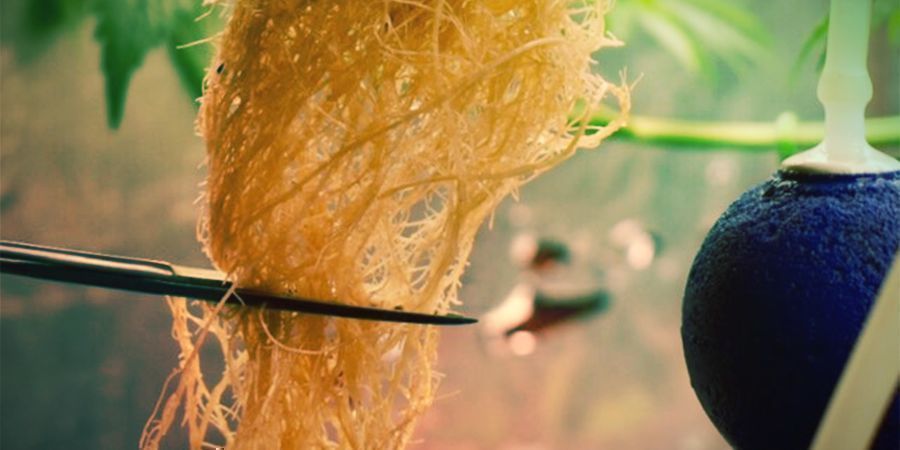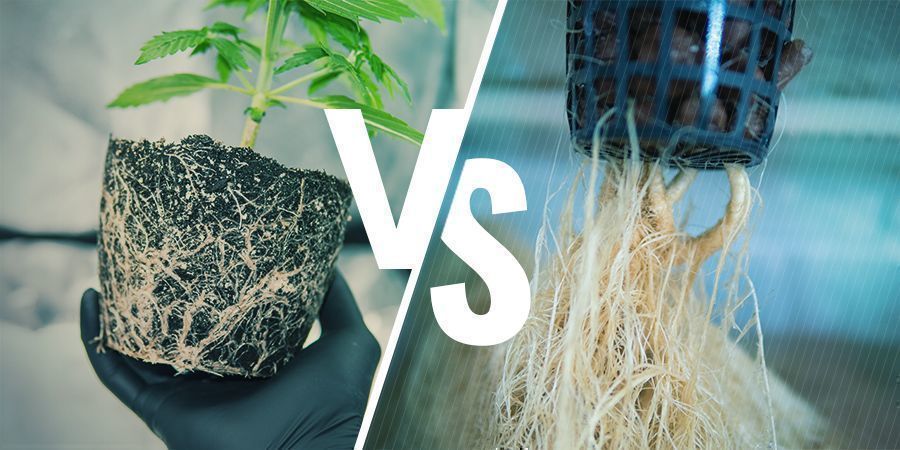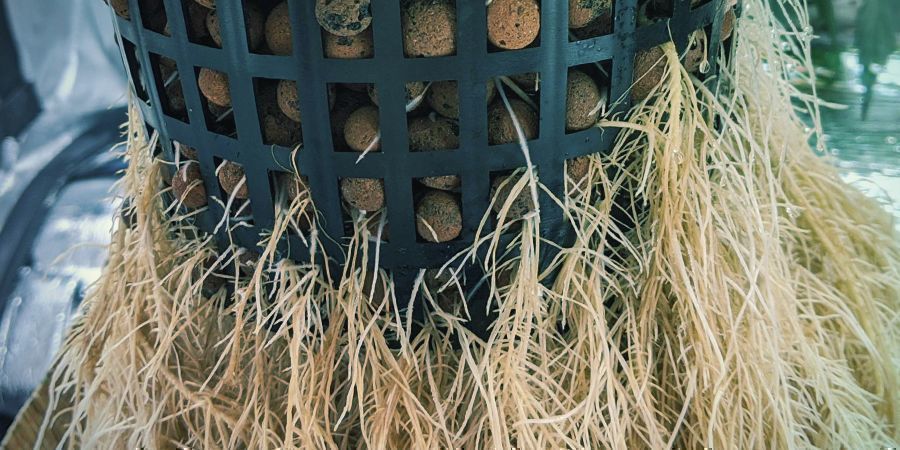How To Increase Cannabis Yields With Root Pru

Growers usually give lots of attention to their cannabis plants, yet the roots are often ignored. Find out how root pruning can benefit the growth, health, and yield of your cannabis plants.
As dedicated cannabis growers, we want the best for our cannabis plants. We spend good money on quality seeds and nutrients, and pay close attention to watering and feeding schedules. But, despite the care most of us put toward our plants, it often happens that the roots are ignored.
As you might imagine, however, the roots are extremely important, as plants use them to take up water, oxygen, and nutrients, all of which they need to grow.
The roots also need room to spread, and will start to grow in a circle once they’ve outgrown their pot, eventually choking off the root mass. This is known as plants becoming “root bound”. When this happens, the function of the roots is hampered, and growing problems and decreased yields are just around the corner.
What Is Cannabis Root Pruning?

With root pruning, you prevent your plants from becoming root bound, boosting their health and production potential as a result. Root pruning is especially important if you’re growing mother plants, as these will become root-bound sooner or later. But root pruning is also beneficial for cannabis that you grow for just one season.
The reason for this is that container-grown cannabis is limited by the volume of its pot. As such, when your plant becomes “root bound”, the normal next step would be to repot into a larger container.
But repotting isn’t always optimal or possible. It stresses plants, and not everyone has the space to constantly “upsize” into bigger containers. For large mother plants, constant up-potting may not be a solution either. At some point, you may need a gigantic container. This isn’t just impractical; with root pruning, it’s also unnecessary.
There are two ways by which you can go about root pruning: One is manual pruning of the roots, and the other is air pruning. Let’s look at the differences between the two.
Air Pruning vs Manual Pruning

As opposed to manual root pruning, where you take a knife directly to your plant’s roots, air pruning happens automatically. Once roots come into contact with fresh air, which happens when they reach the edge of a permeable container, the roots are naturally pruned and grow a double tip.
The new tips will then make their way through the medium again until they again reach the edge of the pot. Compared to plants grown in ordinary (closed) pots, the roots will continuously grow sideways and prune themselves many times. As a result, the root mass will increase significantly, up to 5x more than in an ordinary planter.
What Pots Are Best for Air Pruning?
The principle behind air pruning is that the roots will at some point be exposed to fresh air. The best pots for that purpose are usually made from soft, permeable fabric that allows air and water to flow through. Fabric pots or grow bags, aka “smart pots”, are often made from a porous “geotextile” material. Simple fabric felt pots will also do the job if one is up for a little DIY.
Fabric pots are an excellent way to air-prune your plant's roots, but these containers aren’t always optimal. These larger grow bags tend to lack stability and structure, which makes them problematic for indoor growers especially. This is where air pots come in.
Air pots work just like the aforementioned fabric pots, except they’re made from plastic and have holes on the side. They are sturdier and more robust than floppy fabric “bags”, but are normally also more expensive.
Alternatively, you can also just cut holes or slits into the sides of ordinary pots to create the desired airflow.
The Benefits of Cannabis Root Pruning

Having discussed the principle behind root pruning, let’s look at why we'd want to do it in the first place. Here are some of the benefits of root pruning:
-
Stronger and healthier plants: The root zone of root-pruned plants is up to 500% denser than cannabis grown in a normal pot. This means plants can take up more nutrients and oxygen for improved growth.
-
Increased yields: Plants being able to absorb more nutes and oxygen means bigger, more vigorous specimens with bigger yields to boot!
-
You don’t need to repot your cannabis: With root pruning, be it manually or via the air, your roots won’t outgrow their pot. No need for repotting!
Why Root Pruning Is Essential for Mother Plants

Cannabis is an annual plant, which means nature didn’t intend for you to keep a single plant around for a very long time. If we want to keep a mother plant in the growing phase, this means we need to cheat a little in order to keep her healthy and give us quality cuttings. We can do this “cheating” by pruning the roots, which is indeed essential for mother plants.
When grown in an ordinary container, plants will soon reach a limit determined by the volume of the planter and substrate available. In addition to the roots “choking” themselves at some point, when plants have been growing for too long in the same container, the substrate becomes compacted, with layers of minerals forming on the surface. The poor structure of the substrate makes it difficult for water to penetrate, which leads to dry pockets in the soil and makes uptaking water more difficult. The health of your mother plant will slowly suffer, and so will the quality of your cuttings.
Root pruning can prevent this from happening. Any time you root-prune a mother plant, you’re renewing the plant’s root system, plus you’re also adding fresh substrate. Your mother plant will be happy at all times!
What’s more, some cannabis strains, like certain Hazes, are particularly sensitive to the stress of becoming root-bound. This can even cause plants to start flowering. Not exactly what you want for your precious mother.
When to Prune Cannabis Roots Manually

How do you know if you should root-prune your cannabis? There are certain signs to keep an eye out for:
-
Roots growing out of the holes of the planter: If you see roots coming out of the holes at the bottom of your container, it’s very likely your weed has become root-bound. Time to prune the roots!
-
Branches and stems become hard, woody, and less flexible: This is known as lignification, an otherwise useful function where a plant strengthens its structure as a response to stress. But it is also a sign that your plant has reached its pot limit and urgently requires root pruning.
-
Stunted growth and overall poor plant health: If you see that your plant is not doing well, particularly if it is in a smaller pot for some time, it has likely outgrown its pot. Pruning its roots will revive your plant and provide it with new vigour.
Tools and Guidelines for Cannabis Root Pruning

To manually prune the roots of your cannabis, you will need a number of tools. You will want to keep these tools, and your work area, as clean and sterile as possible. The freshly trimmed roots of your cannabis are highly sensitive to harmful microorganisms.
Tools
- A set of (sharp!) small scissors (bonsai trimmers are optimal, but nail scissors also work)
- A large knife (if you’re pruning potted plants)
- Tweezers (to access small root parts)
- Rubbing alcohol, paper towels (for sterilising your tools)
Guidelines for Root Pruning
-
Don’t prune mother plants right before or right after taking cuttings. Taking cuttings stresses your mother plant significantly. Wait 3–4 weeks for the plant to recover before root pruning.
-
Building on the above point, after you’ve root-pruned a mother, wait at least 3–4 weeks before taking cuttings.
-
Don’t root-prune during bloom! Root pruning a flowering plant will result in greatly decreased yields. You should stop pruning once you’re two weeks out from the beginning of the flowering phase.
-
Don’t root-prune if your plant is stressed or sick. This includes pest infestations, nutrient problems, extreme temperatures, etc. Wait until your plant is healthy and conditions are optimal before you take your knife to the roots.
-
Don’t prune more than about ⅓ of the total root mass. Less is more! If you cut off too much, the drawbacks (stress, recovery time needed, etc.) can outweigh the benefits.
-
Only prune a few centimetres from the outside of the root mass. Prune all sides evenly so you get a nice symmetrical root ball.
-
Keep your root-pruning tools clean and sterile. Use alcohol and paper towels, and wipe your tools between cuts.
-
Don’t root-prune your “regular” cannabis plants more than once per growing season. By "regular", we mean those plants you will harvest at the end of the season. Mother plants should be pruned no more than three times per year.
How to Manually Root-Prune Cannabis Plants
Let’s examine how to best root-prune your cannabis when growing in soil and in hydro.
How to Prune Roots in Soil

Prep Work
-
Prune your plant’s foliage before getting started on the roots. You want to greatly reduce foliar mass by trimming your plant to about ⅔ of its initial height. The reduced leaf mass will help your plant conserve water and nutrients so it can focus energy on growing new roots. This leaf pruning will also allow more light to reach the bottom parts of the plant, benefitting the growth of new shoots.
-
Once you’ve pruned the foliage, allow your plant one week to recover.
Reducing the Root Ball & Adding New Soil
We can now get to the action of our root pruning operation. Make sure the soil is not too dry/wet to reduce stress on your plant.
-
Carefully slide the root ball out from the pot. Place the root ball on the edge of a table as this will greatly help when cutting.
-
Take a large, sterilised knife and make a clean cut about 2–3cm from the bottom of the root ball. Following this, take off 2–3cm from each side of the root ball.
Exactly how big the “slices” should be depends on the overall size of your root ball. Ultimately, you want to take off about ⅓ of the total root mass. On the internet, you will find tutorials of folks cutting off a lot more, leaving just a small cube of the initial ball. We recommend sticking to our method and leaving a bit more of the root mass behind.
-
Once you’ve “shaved off” the bottom and sides of the root ball, your plant is ready to be transplanted into the new substrate. At this point, consider putting the plant into a bigger container. If, for instance, you had your plant in a 7-litre pot, move it into an 11-litre pot. To help with drainage, add a 2–3cm layer of clay pebbles or perlite on the bottom of the new pot.
-
Place your shaved plant into the new pot, and fill up the sides with fresh substrate. Press down a bit on the substrate to compact it a little, but not too much.
-
Water your freshly repotted plant. This is a great opportunity to use a root stimulator! After a few days, your plant will start to grow healthy new shoots.
How to Prune Roots in Hydroponic Systems

If you’re growing hydroponically using deep water culture, nutrient film technique, or aeroponics, you will find that these systems promote the growth of particularly big, white root masses that can quickly outgrow any container. But no worries! Root pruning also works for hydroponics. Indeed, it’s even easier and less messy than when growing in soil.
-
Check the roots to see if you need to prune. One advantage of growing in hydro is that plants can do well even with much smaller root systems. To see whether your roots need some trimming, you should occasionally look “under the hood” of your system. You'll want to prune any roots growing longer than the others to keep everything at about the same length.
-
Remove the pots. Be especially careful to make sure no dirt gets into the hydroponic system as you do so. Remember that freshly cut roots are sensitive to contamination. Don’t let bacteria, mould, or fungus get your plants sick.
-
Sterilise the bonsai clippers or shears. With precise cuts, trim away those roots that have grown too long. The goal is to get an evenly shaped root ball that will nicely fit in your planters.
-
Don’t cut the root crown! Once you start cutting the roots of your hydro plants, it’s easy to get carried away. You may feel like cutting away any part that is discoloured, slimy, or dried out. But do not get too close and damage the “root crown”, where all the roots come together in the centre. Just like in soil, cutting off less is better and safer for your hydroponically grown plants. Cut only those parts that are obviously too long, and take off just a few centimetres from the bottom and the sides to get a nice even root ball. Keep away from where the stem meets the roots.
-
Put the plants back into their pots. Just like when you took the plants out, make sure no debris finds its way into your system.
What to Do With Pruned Cannabis Roots?

At the end of your root-pruning operation, you will likely end up with a handful or two of freshly cut roots. No reason to toss them! Like other organic materials, such as leaves or wood chips, the roots make a good soil amendment. They are a favourite food of all kinds of soil microorganisms that will turn them into plant nutrition.
Roots mixed into poor potting soil will also improve soil texture and water drainage. Alternatively, you can just add the roots to your compost pile and put them to good use that way.
Root-Pruning Aftercare for Cannabis Plants
Root pruning can inflict some major stress on cannabis. But, you can help your plants recover by administering certain additives, such as a root stimulator. Not only do root stimulators promote the growth of new roots, but they also contain ingredients to strengthen plant resistance during periods of vulnerability.
A B-vitamin complex composed of folic acid, B5, and B1 is also beneficial for root development and boosting plant immunity and resistance. Lastly, potassium silicate is another good aftercare supplement as it fights off pathogens and protects and strengthens your plants.














 United States
United States










